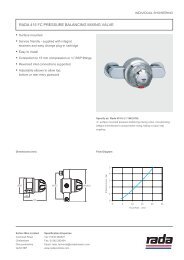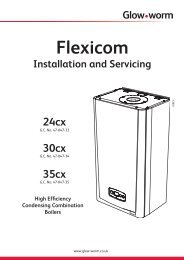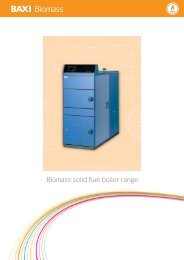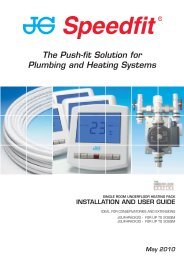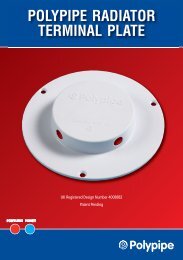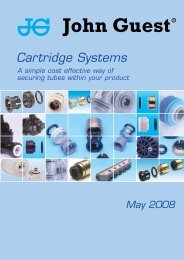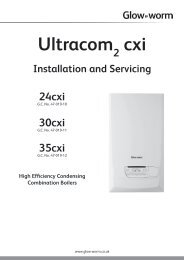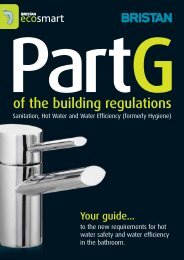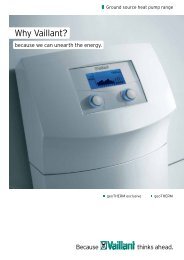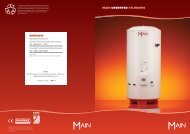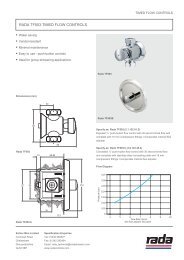Hep20 Technical Handbook
Hep20 Technical Handbook
Hep20 Technical Handbook
Create successful ePaper yourself
Turn your PDF publications into a flip-book with our unique Google optimized e-Paper software.
Hep 2<br />
O ® Design Considerations<br />
Systems Planning<br />
System Sizing Calculation Examples<br />
Domestic cold water pipe sizing<br />
Question: What is the effect on the tap head when 22mm<br />
Hep 2 O ® is used as the distribution pipe from storage cistern?<br />
System information assumptions<br />
Design flow at tap<br />
Frictional loss at tap<br />
Proposed Hep 2 O ® size<br />
0.3 l/s<br />
0.8m head<br />
22mm<br />
Calculation (read with Figure 14 and Table 12)<br />
Measured pipe length (ML): 0.5 + 3 + 5 + 0.5 = 9.0m<br />
Equivalent pipe length (EL): 3 elbows x 0.8 = 2.4m<br />
Total equivalent pipe length (TEL) 11.4m<br />
Head available at tap: 3 – (0.5 + 0.8) = 1.7m head<br />
Available head loss per 100m: 100 x 1.7 = 14.9m<br />
11.4<br />
Using Nomogram 1 (page 61), plot a line from 14.9m on head loss scale<br />
through 0.3 l/s on flow scale and extend over to pipe size scale (shown<br />
by dash line on nomogram).This indicates that proposed 22mm pipe size<br />
would be suitable.To check what the actual head loss is for this size, plot<br />
a line from 22mm on pipe size scale through 0.3 l/s on flow scale, and<br />
extend over to head loss scale (shown by dotted line on nomogram).<br />
This indicates that head loss is 11m per 100m (0.11m per m).<br />
Actual head loss through pipework: 11.4m x 0.11 = 1.254m<br />
Actual flow rate at tap would therefore be slightly higher than design flow.<br />
1m head loss = 9.81 kN/m 2<br />
0.5m<br />
Figure 14<br />
0.5m<br />
Bath tap<br />
Table 12 Equivalent Pipe Lengths for Pipe Sizing<br />
5m<br />
3m<br />
Storage cistern<br />
Gate valve<br />
Domestic hot water pipe sizing<br />
Given sufficient system information for domestic hot water<br />
layouts, pipe sizes may be ascertained with nomogram 2<br />
(page 62) and the calculation method used for domestic cold<br />
water pipe sizing.<br />
Central heating pipe sizing<br />
Question: What is the effect on the pump head when<br />
10mm Hep 2 O ® is used for radiator connections?<br />
System information assumptions<br />
Length of radiator flow pipe<br />
4m<br />
Length of radiator return pipe 5.5m<br />
Flow and return design temperatures 80ºC and 70ºC<br />
Allowance for unusable pipe heat loss 5%<br />
Specific heat capacity of water 4.2<br />
Design output of ‘index’ radiator<br />
1.2 kW<br />
Calculation (read with Figure 15 and Table 12)<br />
Heat load: 1.2 kW + 5% = 1.26 kW<br />
Flow rate: 1.26 = 0.03 l/s<br />
4.2 x (80-70)<br />
Using Nomogram 3 (page 63), plot a line from 10mm diameter on pipe<br />
size scale through 0.03 l/s on flow scale and extend over to head loss<br />
scale, (shown by dash line on nomogram). read head loss value as 14m<br />
per 100m, i.e. 0.14m per m run.<br />
Measured pipe length (ML): 4 + 5.5 = 9.5m<br />
Equivalent pipe length (EL): 4 elbows x 0.2 = 0.8m<br />
2 tees x 0.3 = 0.6m<br />
Total equivalent pipe length (TEL): 10.9m<br />
Pipework head loss: 0.14 x 10.9 = 1.526m head<br />
or 15 kPa<br />
This head must be added to frictional loss of all other circuits on<br />
‘index run’, together with allowances for radiator valves, control valves,<br />
boiler, etc., in order to determine minimum pump head required.<br />
Like copper ‘microbore’ systems, the use of 10mm Hep 2 O ® will require<br />
slightly more pump head than systems using 15mm radiator circuits.<br />
As a general precaution, 10mm Hep 2 O ® should not be used for a<br />
radiator output in excess of 1.5 kW (approximately 5,000Btu) unless<br />
proven by calculation.<br />
Index radiator<br />
Hep 2 O ® diameter Elbow Tee Stopcock<br />
(mm) (m) (m) (m)<br />
10 0.2 0.3 –<br />
15 0.5 0.6 4.0<br />
22 0.8 1.0 7.0<br />
28 1.0 1.5 10.0<br />
Notes:<br />
1. This table is appropriate for pipeline water velocities not exceeding 1.5m/s.<br />
Refer also to Table 15 on page 72.<br />
2. Frictional loss through tees occur on a change of direction only.<br />
3. Frictional loss through fully open gate valves can be ignored.<br />
4. Frictional loss through cold formed bends can be ignored.<br />
Figure 15<br />
60



